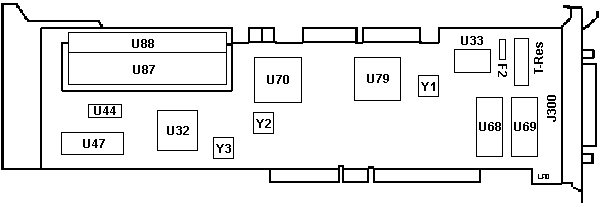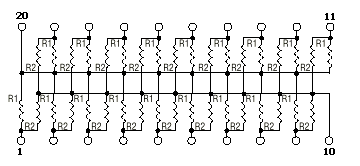IBM SCSI
w/Cache, Triple Oscillator
@8EFF.ADF
-
IBM PS/2 SCSI Adapter w/Cache
C8EFF.ADF
- Init file for _8EFF.ADF
@8EFF.ADF
- IBM PS/2 SCSI Adapter w/Cache
(modified, no ADP, ROM area selectable / German comments)
SCSIFIX.ZIP Finally!
A utility to alter the
number of sectors for a SCSI drive and convert them to a 3.94GB drive!
Bob Eager, you have answered a prayer!
192-067 PS/2 Micro Channel SCSI Adapter with Cache [32 bit busmaster, autoterminating]
SCSI w/Cache, three oscillator, FRU 85F0063
Microcode Differences
10 pin Artifact
on Newest SCSI w/cache
Results from upgrading to 2MB
cache
NEW SCSI
w/cache (Triple
osc)
Terminator
Resistance Values
Termpack FRU
ADF Sections
SCSI with Cache/A
FRU
85F0063

F2
Transorb
J300
C60 Port
T-Res
SCSI terminator
U32
80C188-16
U33
84F8324 Line Interface
U44
SRM20256LM12
U47
BIOS 61G2976
U68
SCSI BIOS Even |
U69
SCSI BIOS Odd
U70
15F6903
U79
33F6715
U87, U88
30 Pin SIMMs
Y1
20.000 MHz
Y2
25.0000 MHz
Y3
32.0000 MHz
0 |
Functions of Late
Adapter Oscillators
20MHz
oscillator is for the SCSI-Line
interface processor.
25MHz
drives the cache controller.
32MHz
is for the 80C186-16 microcontroller,
which supplies the busmaster functions. This card is significantly
faster
than the "old" adapter
° IBM Personal System/2 Micro
Channel SCSI Adapter
with Cache
It has a burst transfer rate of 16.6MBps, adheres to the industry
standard
ANSI SCSI interface and is supported in either a 16- or 32-bit Micro
Channel
slot.
The IBM PS/2 Micro Channel SCSI Adapter
with Cache
is a 32-bit busmaster SCSI adapter containing a 512KB cache buffer that
allows system memory to be totally dedicated to running the application
rather than a portion being reserved for software caching. This SCSI
adapter
is recommended where improved data transfer rates and multiple SCSI
devices
are required and system memory is constrained. However, 512KB
cache
is too small for the LAN Server application.
The "latest" cached SCSI, FRU
85F0063 (FCC-ID is ANOSPRIME),
has no Adaptec chip present and a larger yellow 20-pin DIL terminator
chip
close to the external port. This card has the strange
10-contact card edge connector close to the internal 50-pin
card-edge.
It has a third oscillator as well: a 32.0000MHz (Y3).
Microcode
Differences
From Charles Lasitter
With the triple oscillator (newest) versions of
the Enhanced
SCSI w/cache, I see some Microcode differences but don't see much in
the
way of any particular pattern for when one Microcode will be in use
versus
another.
One adapter has 10G4890 dated 1991. Another has
61G2976
dated 1993. What is the difference between these two
microcodes?
I invariably see the "1993" microcode with some unusual looking cache
SIMMs,
but changing them doesn't seem to make a difference. I see "1993" on
some
boards labeled as "CARD 1" and others" CARD 3". There is
nothing
I can track there.
I can't figure out why they would change it if
they didn't
make something better, but I don't know what that would be or how it
would
manifest itself. I know that the microcode from triple oscillator
adapters
can't be switched to the old unterminated adapters, but I'm uncertain
about
from one two another for the same "3-oscillator" family.
From Tony Ingenoso
(guessing) There may have been a change
to deal
with the low-power mode problems of certain microcode level Kazuza
series
drives... Had to tweak the heads off the cylinder they were
idled
over to keep from losing data when the next write (after power
restoration)
happened to be on that
cylinder... nasty problem...OS/2 had an ABIOS patch to deal
with
it on the pseudo-ESDI versions of the drive.
Terminator
Resistance Values
Fact sheet is HERE

Bourns 4120R-003, -221/331
Model (41 = Molded DIP), 20 Pins, R = Thick Film Low Profile, 003 =
Dual Terminator. Resistance Code in the format R1 / R2, First
2 digits
are significant, Third digit represents the number of zeros to follow.
220 ohm, 330 ohm.
It looks like this..

Termpack FRU
From Tim Clarke
AFAIK, there is only one FRU for the "internal"
termination
resistor pack for the IBM SCSI w/cache (adapter FRU 85F0063)
that
has the appropriate 20-pin socket and the IBM SCSI w/o cache
(adapter
FRU 85F0002). The termination resistor pack (20-pin) is FRU
57F2870
and, provided you insert it with Pin 1 correctly oriented, should work
O.K.
What about that Artifact?
From Ian
Brown
Interesting bit of history this. And no, you won't
find
it documented anywhere. IBM was one of the members of the organisation
that originally set the standards for SCSI, and as usual they had their
own ideas.
One of these 'unique' ideas was the ability to be
able
to set the SCSI ID# remotely from the host adapter rather than having
to
set it on the device itself.
The result of this was the 'legacy' small
connector on
some 'high end' SCSI hosts, and that awkward RS6000 socket as the
external
port, which became the IBM standard for a while.
The idea was good, but be grateful it never took
off,
as I understand it required decoding hardware on the devices, which
could
have left us looking for special 'IBM SCSI' HDD's etc.
It was never fully implemented as far as I know,
SCAM
overtook it.
How did I find out? I went to a 'Big Blue'
re-union recently,
and met one of the original designers of the IBM SCSI host adapters.
I'd
been wondering about that extra connector for years, so I took the
opportunity
to ask him.
AdapterID 8EFF "IBM PS/2
SCSI Adapter w/Cache"
I/O Address
I/O address for adapter. Each adapter
must have
a unique address range
<"3540-3547">,
3548-354F, 3550-3557, 3558-355F, 3560-3567, 3568-356F, 3570-3577,
3578-357F
DMA
Arbitration Level
DMA channel used to transfer data.
< "Level C">,
D, E, 8, 9, B, 1, 3, 5, 6, 7
Fairness
On/Off
Bus Arbitration Fairness. Whether the
adapter will
release control of the bus when it has been using it exclusively
<"On">,
Off"
ROM Wait
State Disable
Whether a wait state is added to accesses of the
ROM on
the adapter.
<"Enable
Wait State>, No Wait State
SCSI Adapter
Address (ID)
SCSI ID of the adapter
<"7">,
6, 5, 4, 3, 2, 1, 0"
ADPItem 1
ROM Address Range
This field shows the address of the 32K block of
memory
that is
assigned to the adapter. Only one SCSI Adapter will have the
ROM
assigned, and any other SCSI Adapter installed will share that
address range. If the ESDI adapter is also installed, then the address
of the SCSI adapter must be greater than the ESDI adapter address.
9595 Main
Page
|


